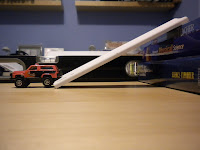This week I participated in a guided inquiry lesson attempting to answer the question: How does the steepness and mass affect the outcome of a collision?
I initially set up the experiment by setting up a ramp with three different incline gradients as shown in the pictures. Using the same marble, I proceeded to roll the marble down the ramp and observed and recorded the distance the toy car traveled from its original position. As you might have expected, the steeper incline produced the furthest results and the more gradual incline produced the least amount of distance. This is due to the combination of the momentum formula and Newton’s second law of motion.
The second experiment set up is pictured below, with only the steepest ramp used. Instead of using the different gradients, I used a smaller marble with less mass. As expected the marble with less mass produced the least amount of momentum transfer and the more massive marble produced a larger transfer of force resulting in a distance twice a far as the light marble.
If I were to modify the result to provide more evidence for Newton’s second law, I would use a different vehicle, some more massive and some less massive to show that a greater force is needed to move an object with more mass. I would also experiment with the types of surfaces used to roll down the marble to enhance the lesson to include friction. Since this experiment can potentially have so many variables one of the challenges would be to try and reduce the amount of variables a student or group of students will experiment with. Once multiple independent variables come into play, student results will become more inaccurate and less reproducible.
Having students come up with their own experiments using materials to suit their interests would make this activity more engaging. Skateboarders could use skateboards and ramps, while baseball players could experiment with friction on grass versus dirt, etc. This would allow students the freedom to create and invent their own procedures resulting in more variety of products.
Students can ultimately learn that science can produce similar results using different materials. One can prove Newton’s laws of motion in more than one way. These laws hold true regardless of the environment or circumstances a person or object is placed in. I believe students can gain the skills to provide evidence of the laws of motion in various ways and think creatively and critically about how to go about achieving that goal.





Hi Julius
ReplyDeleteI really like how you included images in your post. I did a similar inquiry this past week, but I had a look at how the various surfaces affected the momentum of the two marbles. It was quite interesting, but you are very right in that we both came up with a similar conclusion. The heavier object does carry with it more momentum, even on different surfaces as I found out. I also think that if we provide students with various materials, it is very possible for them to investigate and prove Newton's laws of motion. This way, they are constructing their own knowledge in a more meaningful way. I like your idea about differentiating the investigations with student interests, like baseball. I never thought of that before.